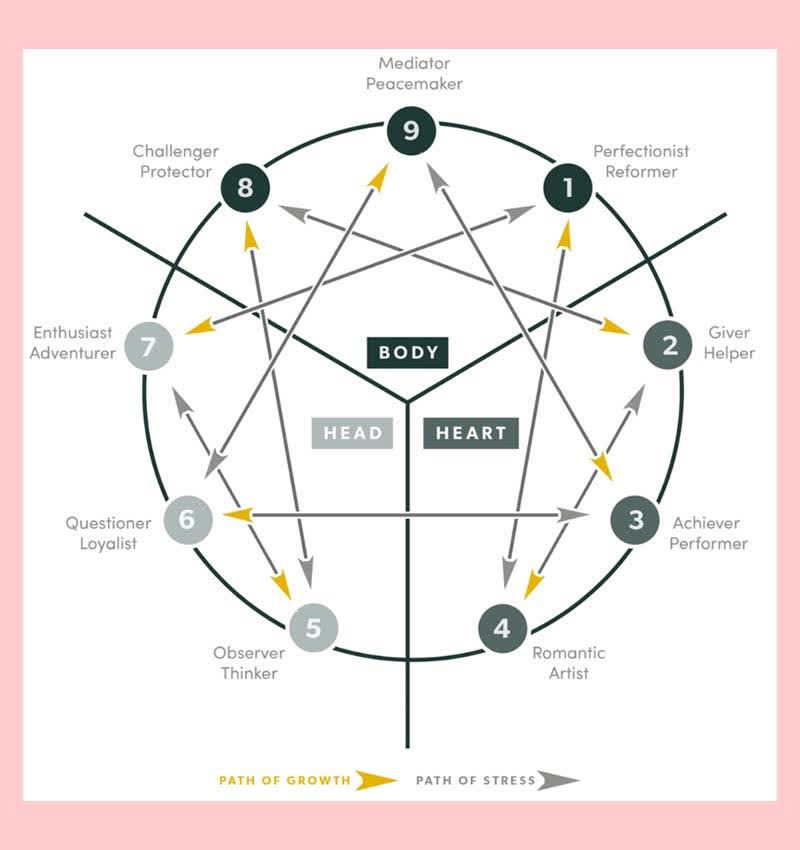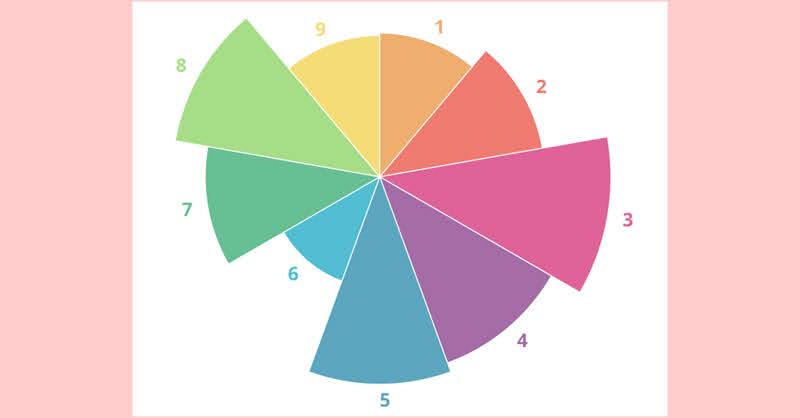The Enneagram chart is a visual representation of the Enneagram system. It may look complex at first, but once you know the basics, you’ll find it easy to understand
It’s not complicated to read and understand the Enneagram chart though it might appear complex at first. As long as you master the basics, you will no longer find yourself confused looking at an Enneagram chart/diagram or your Enneagram test results.
Basically speaking, the Enneagram chart is a visual representation of the Enneagram system, illustrating the 9-pointed geometric structure and interconnectedness between the 9 personality types.
At its core, the circular chart consists of nine interconnected points, with each point representing a specific personality type associated with unique patterns of thinking, feeling, and behaving.
Of course, the Enneagram chart and Enneagram system are not just about these core types alone but also the connection between them through important components like lines, arrows, triads, and wings, reflecting the dynamics and complexity of human nature. These things can all be found on a single circular Enneagram diagram, giving individuals a clear and complete picture of their own personality. By looking at the chart and understanding the meanings behind different components of the Enneagram system, you can acquire more profound insights into yourself and others and learn how to grow and develop positively.
The Enneagram chart may look complex at first glance; however, once you know the basics, you will find it insightful and handy, giving you a complete understanding of your personality. Certainly, the Enneagram circle chart is not as complicated as you think. If you are new to Enneagram, it's a must to familiarize yourself with its key components: the 09 types, triad, wings, and arrows.

The Enneagram types are the core of the system, each type representing a unique set of characteristics, fears, desires, and motivations that shape different patterns of thinking, feeling, and behavior. Each type also has a unique social style, strengths, challenges, and a path of growth and development.
There are a total of nine types, numbered from 1 to 9, each with its descriptive names, such as the Perfectionist, the Helper, the Achiever, etc. At the top of the Enneagram type chart lies the number nine, followed by numbers from 1 to 8 in a clockwise direction (like shown in the above image). The following is the full list of nine Enneagram types and their common descriptive names:
In addition to the nine types, the Enneagram chart includes the concept of triads, which categorize the nine types into three groups based on their shared commonalities. It’s worth noting that though there are different ways of grouping nine types into three groups of three, categorizing them based on their primary centers of intelligence (the gut or instinctive center, the heart or feeling center, and the head or thinking center), aka the Centers of Intelligence Triad, is the most common.
These triads not only explain how different types of the Enneagram structure connect or relate to each other but also provide insights on whether a person tends to make decisions and react to most situations in life through the Gut, Heart, or Head Center. Plus, Enneagram Triads can tell a lot about a person's behavioral drivers, how they process emotions and cope with challenges, and why they keep reacting in a certain way.
Wings also play a significant role in the Enneagram system. They refer to the two types adjacent to each primary type on the Enneagram circle, which may considerably influence our core type. Each type has two possible wings, one on the left and the other on the right, but usually, just one wing is more dominant.
These wings, particularly the dominant wing, can add some traits and characteristics to the primary type, enriching depth and complexity to our overall personality.
For example, if you are a Type One (the Perfectionist), you’ll have either a Nine-wing or a Two-wing as your dominant wing. One is always your core type, while your wing may change from one to another depending on various factors, like life experiences, self-awareness, personal development efforts, and more.
In the Enneagram charts, you can easily see nine overlapping lines connecting different types. They are Enneagram arrows, indicating the directions in which each type may move when stressed and during growth.
To be more specific, all nine personality types have two arrows, one pointing away from it and one pointing towards it, often referred to as stress and growth arrows, respectively.
These arrows let us know the personality traits we may take on when stressed or in times of growth.
By looking at the Enneagram chart with arrows, we can easily understand the direction in which we may shift under different circumstances.
For instance, if you are an Enneagram Type 1, your growth arrows will lead you to Type 7 (the Enthusiast). That means, when experiencing growth or maturity and feeling secure, you may take on positive traits of Type 7s when they are healthy, such as becoming more open-minded, spontaneous, and playful, allowing you to loosen rigid standards. On the other hand, when stressed and in an unbalanced state, Type One moves along the stress to Type 4 (the Individualist), causing you to become self-conscious and overly critical.
Here’s a look at six simple and easy steps to help you read the Enneagram chart and gain deeper insights into your personality and growth opportunities.
These are basic things that help you read an Enneagram chart or diagram easily and correctly. Still, the crucial factor lies in whether or not you can accurately identify your core Enneagram type. Thus, it’s recommended to reflect on your own experiences and behaviors (alongside taking the test or using the self-typing methods) so that you can determine which type resonates most strongly with you.
Understanding the Enneagram chart can be a transformative experience, offering a wide variety of benefits for personal growth and development as well as improving your relationships and communication. By exploring the chart, you can gain valuable insights into your core motivation, fear, desire, strengths, weaknesses, areas for improvement, possible additional traits influenced by the wing, how you make decisions, and more.
Additionally, delving into the Enneagram chart can help you recognize your patterns of behavior under stress and growth. This, of course, allows you to learn from the other types and make conscious choices for positive transformation. The chart also helps you to appreciate the diversity and complexity of human personality and to cultivate more compassion and empathy for yourself and others.
However, while the Enneagram chart is an essential tool for self-discovery, a rigid interpretation can limit its usefulness and even lead to oversimplification or misidentification of one's personality, potentially limiting individual exploration and growth. It's crucial to approach the Enneagram chart with openness and flexibility, using it as a tool for insight rather than a definitive classification.

After completing an Enneagram test, you may receive a visual representation of your results to aid in understanding your overall personality. It's a breakdown of your scores or percentages, showcasing your lowest, medium, and highest ranking results for each of the nine personality types based on your responses to the test questions. Looking at this visual chart, you can identify the three following things:
It’s not an exaggeration to say that the Enneagram chart is a valuable tool for self-discovery, personal development, and enhanced relationships. It may appear complex at first, but when you learn basic things about the chart and know how to interpret it, you will have a more complete view of your personality by delving into other components (alongside your type), including your type, arrows, Centers of Intelligence, etc. Still, it’s crucial to note that Enneagram is a profound system for personal growth that you can continue to explore and learn more about after mastering the basics.
On our website, you can read more useful articles, one of which is What Are Enneagram Arrows & How To Use Them For Growth?.